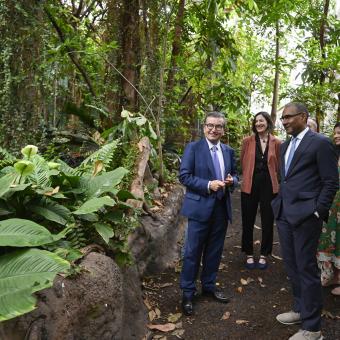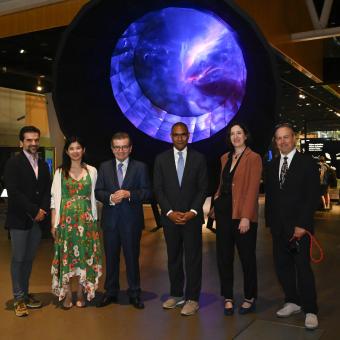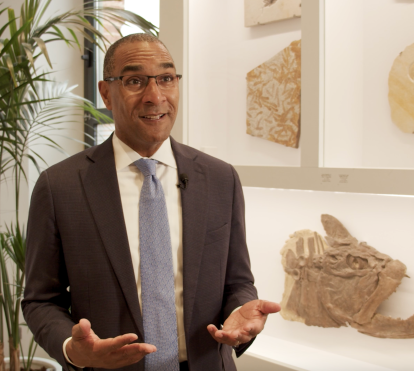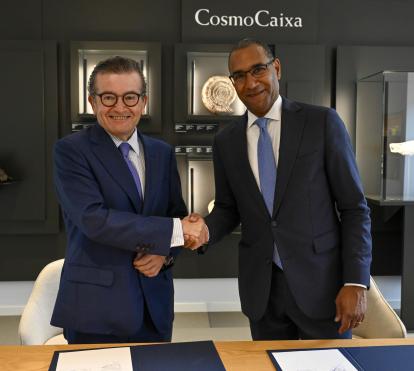
The ”la Caixa” Foundation and the American Museum of Natural History announce collaborative partnership to bring scientific exhibitions to countries around the world
01.07.24
4 minutes readThe ”la Caixa” Foundation and the American Museum of Natural History in New York have signed a collaboration agreement to showcase scientific exhibitions created by the ”la Caixa” Foundation in various international museums until 2029, and to bring content created by the Museum to the CaixaForum and CosmoCaixa network of centres. The ”la Caixa” exhibitions that global visitors will be able to discover under the agreement span a range of scientific topics, including human perception, evolution, anthropology, and technology. This summer, the partnership will also bring an activity on space exploration created by the Museum to CosmoCaixa in Barcelona, Spain.
“Through scientific knowledge, we can face the greatest challenges of this century. Making science, an inexhaustible engine of social progress, accessible to all citizens in an understandable and attractive way is one of the objectives of the ”la Caixa” Foundation’s exhibitions. We are delighted that content of the highest rigour and quality, which has already been enjoyed in our network of centres, is now making the leap to other museums through an invaluable partner like the American Museum of Natural History,” said Juan Ramón Fuertes, deputy general manager of the ”la Caixa” Foundation.
“The American Museum of Natural History has long been committed to broadening the public understanding of science and the ”la Caixa” Foundation has been dedicated to that same purpose,” said Museum President Sean M. Decatur. “Science is something that truly belongs to everyone and can help us understand our place in the world and the universe. This partnership is an amazing opportunity for our two institutions to bring the wonders of scientific discovery to a global audience.”
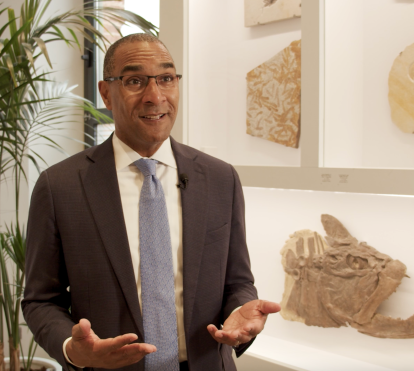
In addition to millions of annual visitors, the Museum is a world leader in the production and management of travelling exhibitions and Space Shows that touch millions more around the globe. Currently, the Museum has over 20 exhibitions and five planetarium shows on tour, and has brought content to more than 400 cities across 55 countries.
Under the agreement with ”la Caixa” Foundation, the Museum becomes the exclusive partner in taking scientific exhibitions created by ”la Caixa” to museums worldwide until 2029. The agreement also provides the opportunity for joint activities between the two institutions, and for the CaixaForum network of centres and CosmoCaixa to host exhibitions created by the Museum. For example, this summer, as part of CosmoNits, CosmoCaixa will host, “The Grand Tour”, an activity from the Museum in which participants will travel through the points where humankind has reached with space missions, using a projection created with software that simulates the known universe. The journey will be directed and narrated by Museum astrophysicist and educator Jackie Faherty.
The following are the first scientific exhibitions by the ”la Caixa” Foundation that will be showcased at the international level as part of the collaboration:
- Mirrors. Inside and Outside Reality. In this exhibition, the important role of mirrors is revealed in different areas of science, culture and life in general in a completely interactive way. The exhibition explores the effects and peculiarities of mirrors to understand the various physical and mathematical phenomena related to these objects, which have been fundamental to some important scientific discoveries. Following its premiere at CosmoCaixa in 2019, the exhibition has been touring the CaixaForum network of centres. During 2025, it will also be shown at the UC Exploratório in Coimbra, as part of a collaboration with the Centro Ciência Viva.
- Talking Brains. Programmed to talk. Using virtual reality, encephalography and various experiences, Talking Brains invites visitors to experiment with their own brains and discover, among other things, the secrets of this complex organ and the origins of the 7,000 different languages spoken around the world. This exhibition began its tour at CosmoCaixa, has since been displayed in three CaixaForum centres and the Museu de les Ciències de València, and can currently be visited at the Pavilhão do Conhecimento in Lisbon until 1 September, thanks to an agreement with the Centro Ciência Viva.
- Print3D. Reprinting Reality. Through more than 200 pieces created with 3D printers, visitors can learn how this versatile technology works, and its ability to customise all kinds of objects for a wide range of fields, such as medicine, engineering, art or architecture. It was first shown at CosmoCaixa and then in six centres in the CaixaForum network, where it will continue to tour during the 2024-2025 season.
- Homo Ludens. Videogames to understand the present. This exhibition offers an anthropological look at video games, a cultural, aesthetic and artistic phenomenon that is essential in our times. It presents 55 works by 28 creators, including video games and contemporary works of art, The exhibition, which has visited various centres in the CaixaForum network, offers an innovative route in which the spectator becomes the protagonist of a gamified and participatory experience that offers a reflection on the central role of play in our culture based on this phenomenon.
About the American Museum of Natural History (AMNH)
The American Museum of Natural History, founded in 1869 with a dual mission of scientific research and science education, is one of the world’s preeminent scientific, educational, and cultural institutions. The Museum encompasses more than 40 permanent exhibition halls, galleries for temporary exhibitions, the Rose Center for Earth and Space including the Hayden Planetarium, and the Richard Gilder Center for Science, Education, and Innovation. The Museum’s scientists draw on a world-class permanent collection of more than 30 million specimens and artifacts, some of which are billions of years old, and on one of the largest natural history libraries in the world. Through its Richard Gilder Graduate School, the Museum offers two of the only free-standing, degree-granting programs of their kind at any museum in the U.S.: the Ph.D. program in Comparative Biology and the Master of Arts in Teaching (MAT) Earth Science residency program. Visit amnh.org for more information.

